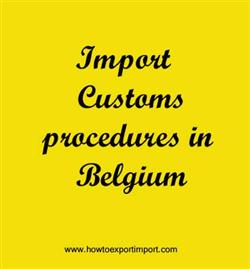Customs clearance process required in Belgium
Who are the parties involved in import customs clearance formalities in Belgium? Import cargo clearance in Belgium Customs. What is the customs process in Belgium to import? How is import cargo released from Belgium Customs to importer?
The information provided here details on how to import goods to Belgium especially import customs clearance procedures in Belgium.

The official Customs and Excise department of Belgium is administered by Federal Public Service under the Ministry of Finance (FPS Finance).
The Operators are required to fill out an Entry Summary Declaration (ENS) to the customs of the country of entry, prior to the goods are brought into the customs territory of the Union, using the electronic procedure (Union Customs Code - UCC).
Importers should submit or enter the required data in the import clearance system via an EDI interface to the Customs computer Paperless Customs and Excises (PLDA) system. The import declaration, including security data, has been compulsorily submitted online via the PLDA-program (ICS = Import Control System).
The importer can likewise declare the goods by presenting a finished Single Administrative Document (SAD form) to Belgian Customs. The official model for written declarations to customs is the Single Administrative Document (SAD). The SAD delineates products and their movement around the world and is fundamental for trade outside the EU, or of non-EU merchandise. Merchandise brought into the EU customs area is, from the time of their entrance, subject to customs supervision until customs formalities are finished. Items are secured by a Summary Declaration which is documented once the things have been shown to customs authorities.
The Summary Declaration can be made on a form gave by the customs authorities. In any case, customs authorities may in like manner allow the utilization of any commercial or official document that contains the specific data required to perceive the merchandise. The SAD fills in as the EU importer's declaration. It incorporates both customs duties and VAT and is considerable in all EU member states. The declaration is made by whoever is clearing the good, typically the importer of record or his/her agent.
Import customs clearance methodology to deliver imported goods to importer is same in almost all ports worldwide. Detailed information about import customs process is explained separately in this website. Click below to read the same.
Import Customs Process in importing country
The information provided here details on how to import goods to Belgium especially import customs clearance procedures in Belgium.
The following details also clarify:
How can I clear customs to import in Liège. What Customs formalities required to import in Antwerp. Import customs procedures required in Brussels. Import Customs process in Ostend . Process to import to Antwerp. Requirements of customs to import to Liège. Customs requirements in Brussels to import. Customs needed to import to Ostend .
Learn Exports Imports Free, Click here
Click here to know GST rate of your goods or service
What is the difference between BAF and CAF
What is the difference between High sea sales and imports
What is the difference between re-exports and re-imports
How does First Appraisement system of import customs clearance procedures work?
How does Letter of Credit work?
How does Bill of Lading work in DP payment terms?
How does STP units work in India?
The term FCL. What is FCL means
How does a Running bond work?
Travelers to India under import duty exemption, Frequently Asked Questions Part 2
How to Import to Equatorial Guinea?
How to import to India from Equatorial Guinea?
How to export from India to Equatorial Guinea?
CGST Act section 51 Tax deduction at source
CGST Act Section 52 Collection of tax at source
CGST Act section 53 Transfer of input tax credit
CGST Act section 54 Refund of tax
CGST Act Section 55 Refund in certain cases
CGST Act section 56 Interest on delayed refunds
CGST Act section 57 Consumer Welfare Fund
CGST Act section 58 Utilisation of Fund
CGST Act Section 59 Self-assessment
CGST Act section 60 Provisional assessment
CGST Act section 61 Scrutiny of returns
CGST Act Section 62 Assessment of non-filers of returns
CGST Act section 63 Assessment of unregistered persons
Revised GST rate on goods, 21.07.2018
What is Refund of Interest under GST
E way Bill decision taken by 26th GST Council on 10th March
Tax exemption for exporters, 26th GST council